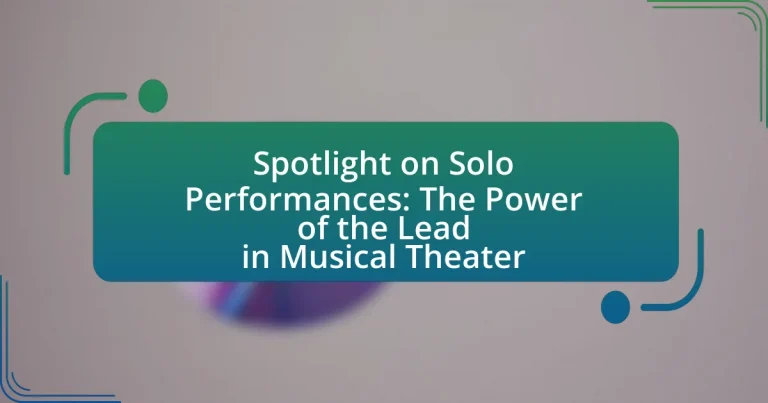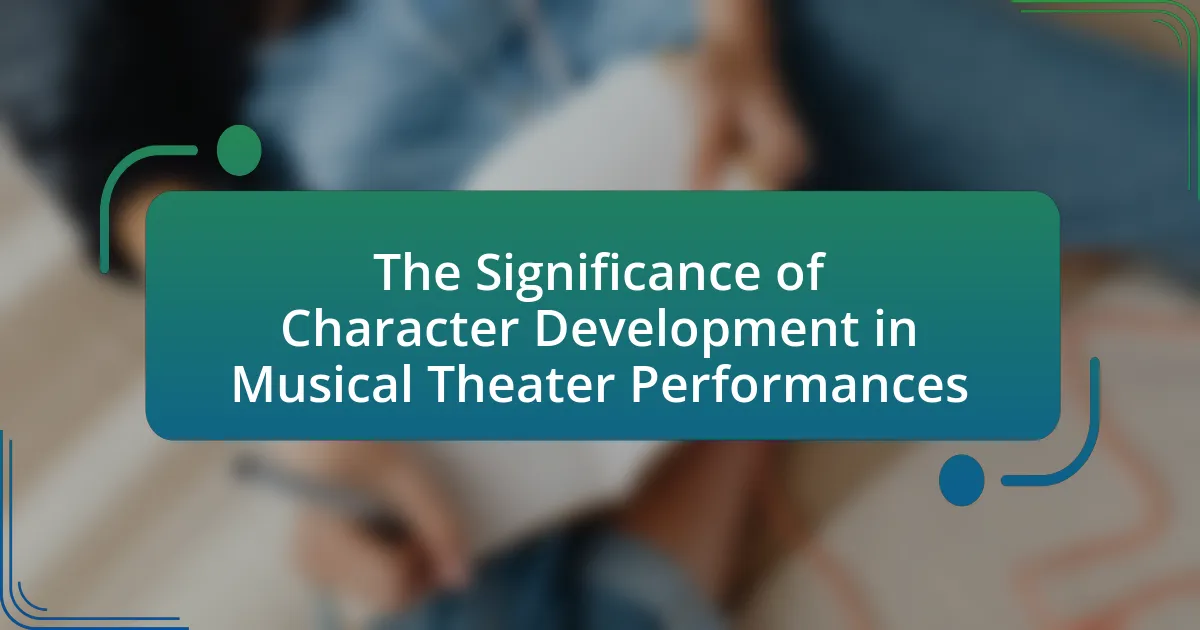The article “Spotlight on Solo Performances: The Power of the Lead in Musical Theater” examines the significance of solo performances within the context of musical theater, highlighting their role in character development and emotional storytelling. It differentiates solo performances from ensemble pieces, emphasizing the unique connection a single performer establishes with the audience. Key characteristics of successful solo performances, the challenges faced by lead performers, and the techniques used to prepare for roles are discussed. Additionally, the article explores the psychological effects of solo performances on viewers and the importance of audience engagement in enhancing the overall experience. Resources for aspiring performers and best practices for honing their craft are also outlined, providing a comprehensive overview of the dynamics involved in solo performances in musical theater.

What defines solo performances in musical theater?
Solo performances in musical theater are defined by a single performer taking the stage to deliver a song or monologue that expresses their character’s emotions, thoughts, or narrative. This format allows for deep character exploration and emotional connection with the audience, often showcasing the performer’s vocal and acting abilities. Historical examples include iconic solos like “Defying Gravity” from “Wicked,” which highlights the character’s internal struggle and aspirations, demonstrating how solo performances can drive the plot and develop character arcs.
How do solo performances differ from ensemble pieces?
Solo performances differ from ensemble pieces primarily in the focus on a single performer versus a group of performers. In solo performances, the individual artist takes center stage, showcasing their unique talents, emotional expression, and personal interpretation of the material. This allows for a deep connection with the audience, as the soloist conveys their personal narrative and emotions through their performance. In contrast, ensemble pieces involve multiple performers collaborating, which emphasizes harmony, teamwork, and collective storytelling. The dynamics of ensemble performances often require coordination and blending of voices or instruments, creating a richer, more complex sound but diluting individual expression. This distinction is evident in musical theater, where lead roles often carry the narrative weight in solo performances, while ensemble roles support the overall production through shared themes and collective energy.
What are the key characteristics of a successful solo performance?
A successful solo performance is characterized by strong emotional connection, technical proficiency, and engaging stage presence. Emotional connection allows the performer to resonate with the audience, making the experience more impactful. Technical proficiency ensures that the performer can execute the required vocal and physical skills, which is essential in musical theater. Engaging stage presence captivates the audience’s attention, drawing them into the performance. These characteristics are supported by studies indicating that performers who effectively convey emotion and maintain audience engagement tend to receive higher ratings in performance evaluations.
How does the role of the lead influence the overall production?
The role of the lead significantly influences the overall production by setting the tone and direction of the performance. The lead actor’s interpretation of their character shapes audience perception and engagement, as they often carry the narrative’s emotional weight. For instance, a strong lead can elevate the quality of the entire cast’s performance, as seen in productions like “Hamilton,” where Lin-Manuel Miranda’s portrayal of Alexander Hamilton drove both critical acclaim and audience connection. This central role also impacts the pacing and energy of the show, as the lead’s performance can dictate the rhythm and flow of scenes, ultimately affecting the audience’s overall experience.
Why are solo performances significant in storytelling?
Solo performances are significant in storytelling because they allow for deep character exploration and emotional connection. In musical theater, a solo performance often serves as a pivotal moment where the character reveals their inner thoughts and feelings, creating a direct line of communication with the audience. For instance, songs like “Defying Gravity” from “Wicked” encapsulate a character’s transformation and aspirations, making the audience empathize with their journey. This intimate focus enhances narrative depth and engages viewers on a personal level, reinforcing the importance of the lead’s perspective in the overall story.
How do solo performances convey character development?
Solo performances convey character development by allowing the audience to experience a character’s internal thoughts and emotions in a focused manner. This intimate format enables performers to express nuanced feelings through vocal delivery, body language, and song lyrics, which reveal the character’s motivations and transformations. For instance, in musical theater, a character’s solo number often serves as a pivotal moment that encapsulates their journey, showcasing their struggles and aspirations. This technique is evident in productions like “Les Misérables,” where Jean Valjean’s solo “Bring Him Home” illustrates his deep sense of love and sacrifice, effectively marking his character’s evolution. Such performances create a direct emotional connection, facilitating a deeper understanding of the character’s development throughout the narrative.
What emotional impact do solo performances have on the audience?
Solo performances evoke a profound emotional impact on the audience by creating an intimate connection between the performer and the viewers. This connection often leads to heightened emotional responses, such as empathy, joy, or sadness, as the audience experiences the performer’s vulnerability and authenticity. Research indicates that solo performances can trigger mirror neurons in the audience, facilitating emotional resonance and allowing viewers to feel the performer’s emotions more deeply. For example, a study published in the journal “Emotion” by Decety and Jackson (2004) found that witnessing emotional expressions can elicit similar feelings in observers, reinforcing the emotional bond formed during solo performances.

What are the challenges faced by lead performers in musical theater?
Lead performers in musical theater face several challenges, including vocal strain, emotional demands, and the pressure of audience expectations. Vocal strain occurs due to the need for powerful singing over orchestras and in large venues, often leading to fatigue or injury. Emotional demands arise from portraying complex characters and conveying deep feelings, which can be mentally exhausting. Additionally, the pressure of audience expectations can create anxiety, as lead performers are often the focal point of the production and are expected to deliver flawless performances consistently. These challenges are well-documented in studies on performer well-being, highlighting the need for proper training and support systems in the industry.
How do lead performers prepare for their roles?
Lead performers prepare for their roles through a combination of script analysis, character study, vocal training, and physical conditioning. They begin by thoroughly analyzing the script to understand their character’s motivations, relationships, and development throughout the story. This analysis is often complemented by extensive research into the character’s background and the context of the musical.
Additionally, lead performers engage in vocal training to ensure they can deliver their songs effectively, often working with vocal coaches to refine their technique and range. Physical conditioning is also crucial, as performers may participate in dance rehearsals and fitness routines to maintain stamina and agility required for demanding performances.
These preparation methods are supported by industry practices, where successful lead performers often cite the importance of these techniques in interviews and behind-the-scenes documentaries, highlighting their role in delivering compelling performances.
What techniques do they use to develop their characters?
Musical theater performers use techniques such as character backstory development, emotional connection, and physical embodiment to develop their characters. Character backstory development involves creating a detailed history for the character, which informs their motivations and actions on stage. Emotional connection is established through the performer’s ability to convey genuine feelings, often achieved through personal experiences or empathy with the character’s situation. Physical embodiment includes the use of body language, vocal variation, and movement to portray the character’s personality and emotional state effectively. These techniques are essential for creating a believable and engaging performance that resonates with the audience.
How do they manage stage fright and performance anxiety?
Performers manage stage fright and performance anxiety through various techniques such as deep breathing, visualization, and preparation. Deep breathing helps to calm the nervous system, allowing performers to focus and reduce anxiety levels. Visualization involves imagining a successful performance, which can enhance confidence and reduce fear. Additionally, thorough preparation and practice can instill a sense of control and readiness, further alleviating anxiety. Research indicates that these methods are effective; for instance, a study published in the Journal of Applied Psychology found that performers who engaged in mental rehearsal experienced lower anxiety levels and improved performance outcomes.
What role does vocal technique play in solo performances?
Vocal technique is crucial in solo performances as it directly influences the singer’s ability to project their voice, convey emotion, and maintain vocal health. Effective vocal techniques, such as breath control, pitch accuracy, and resonance, enable performers to deliver powerful and expressive interpretations of their songs. Research indicates that singers who utilize proper vocal techniques experience less strain and fatigue, allowing for longer and more dynamic performances. For instance, a study published in the Journal of Voice highlights that singers employing techniques like diaphragmatic breathing can sustain notes longer and with greater clarity, enhancing their overall performance quality.
How do vocal choices enhance character portrayal?
Vocal choices significantly enhance character portrayal by conveying emotions, personality traits, and intentions. For instance, variations in pitch, tone, and volume can reflect a character’s emotional state, such as using a soft, trembling voice to express fear or a booming voice to convey authority. Research indicates that specific vocal qualities can influence audience perception, with studies showing that higher pitches are often associated with youthfulness and lower pitches with maturity (Titze, 2000). Additionally, the use of accents or dialects can provide cultural context and depth to a character, making them more relatable and authentic. Thus, deliberate vocal choices are essential tools for actors to create nuanced and compelling character portrayals in musical theater.
What are common vocal challenges faced by lead performers?
Lead performers commonly face vocal challenges such as vocal strain, pitch control, and stamina. Vocal strain occurs due to the demands of projecting their voice over an orchestra and maintaining clarity, which can lead to fatigue and potential vocal damage. Pitch control is critical, as lead performers must consistently hit accurate notes, especially during emotionally charged moments, where tension can affect their vocal precision. Stamina is essential for sustaining vocal performance throughout long shows, often requiring extensive rehearsal and performance schedules that can exhaust the voice. These challenges are well-documented in vocal pedagogy, emphasizing the importance of proper technique and vocal health management for successful performances.

How do solo performances impact the audience experience?
Solo performances significantly enhance the audience experience by creating an intimate connection between the performer and the viewers. This direct engagement allows the audience to experience the emotions and storytelling in a more personal and impactful way. Research indicates that solo performances can evoke stronger emotional responses, as the audience focuses on a single performer’s expression and interpretation, leading to a heightened sense of empathy and connection. For instance, a study published in the Journal of Applied Arts and Health found that audiences reported increased emotional engagement and satisfaction when witnessing solo acts compared to ensemble performances. This demonstrates that the singular focus of solo performances can profoundly shape the audience’s overall experience.
What are the psychological effects of solo performances on viewers?
Solo performances have significant psychological effects on viewers, primarily evoking emotional responses such as empathy, connection, and introspection. Research indicates that when audiences witness a solo performer, they often experience heightened emotional engagement due to the intimate nature of the performance, which allows for a deeper connection with the character and narrative. For instance, a study published in the journal “Psychology of Aesthetics, Creativity, and the Arts” found that solo performances can lead to increased feelings of empathy and emotional resonance, as viewers project their own experiences onto the performer. This phenomenon is further supported by the concept of “transportation,” where audiences become mentally and emotionally immersed in the story being told, enhancing their overall psychological experience.
How do solo performances create a connection between the performer and the audience?
Solo performances create a connection between the performer and the audience through direct emotional engagement and vulnerability. When a performer takes the stage alone, they have the opportunity to convey personal stories and emotions, allowing the audience to experience a shared journey. This intimacy fosters a sense of empathy, as the audience can relate to the performer’s feelings and experiences. Research indicates that emotional expression in performance can enhance audience engagement, as seen in studies by the University of California, which found that solo acts often elicit stronger emotional responses compared to group performances. This connection is further strengthened by the performer’s ability to make eye contact and interact with the audience, creating a unique bond that enhances the overall experience.
What role does audience engagement play in the success of a solo performance?
Audience engagement is crucial for the success of a solo performance as it directly influences the emotional connection between the performer and the audience. When an audience is actively engaged, they are more likely to respond positively, enhancing the overall impact of the performance. Research indicates that performances with high audience interaction lead to increased satisfaction and retention of the material presented. For instance, a study published in the Journal of Applied Arts and Health found that performers who engaged with their audience through eye contact and responsive dialogue received higher ratings for emotional resonance and memorability. This demonstrates that effective audience engagement not only elevates the performance experience but also contributes significantly to its success.
What are best practices for aspiring lead performers in musical theater?
Aspiring lead performers in musical theater should focus on continuous vocal training, acting techniques, and stage presence. Vocal training is essential as it enhances vocal range and control, which are critical for lead roles. Acting techniques, such as character analysis and emotional connection, help performers deliver authentic performances. Additionally, developing stage presence through movement and confidence captivates the audience. Research indicates that performers who engage in regular practice and receive feedback from experienced mentors improve their skills significantly, leading to better audition outcomes and performance quality.
How can performers effectively hone their craft?
Performers can effectively hone their craft by engaging in consistent practice, seeking constructive feedback, and participating in workshops or classes. Consistent practice allows performers to refine their skills and techniques, while constructive feedback from peers or mentors helps identify areas for improvement. Additionally, workshops and classes provide opportunities to learn new methods and gain insights from experienced professionals, which is essential in the dynamic field of musical theater. Research indicates that deliberate practice, characterized by focused and goal-oriented training, significantly enhances performance skills (Ericsson et al., 1993).
What resources are available for training and development in solo performances?
Resources available for training and development in solo performances include online courses, workshops, and mentorship programs specifically designed for performers. Online platforms like MasterClass and Coursera offer courses taught by industry professionals, covering vocal techniques, stage presence, and performance skills. Workshops conducted by theater companies and performing arts schools provide hands-on experience and feedback from experienced instructors. Additionally, mentorship programs connect emerging artists with seasoned performers, offering personalized guidance and insights into the craft. These resources collectively enhance the skills necessary for successful solo performances in musical theater.




